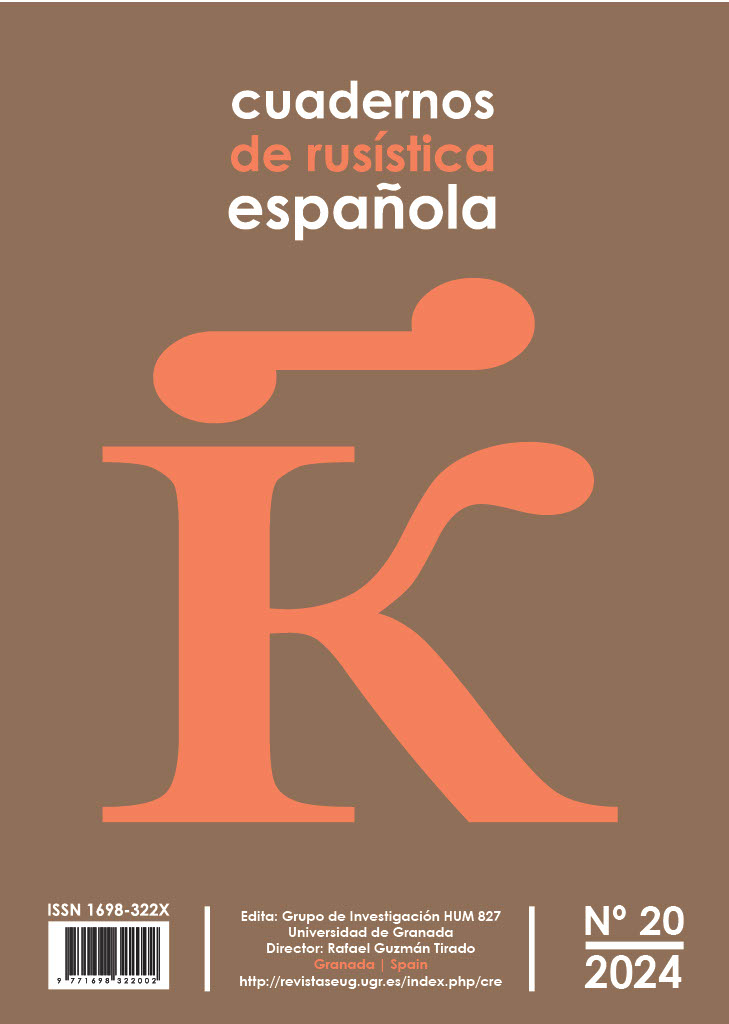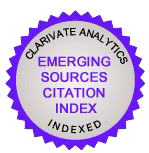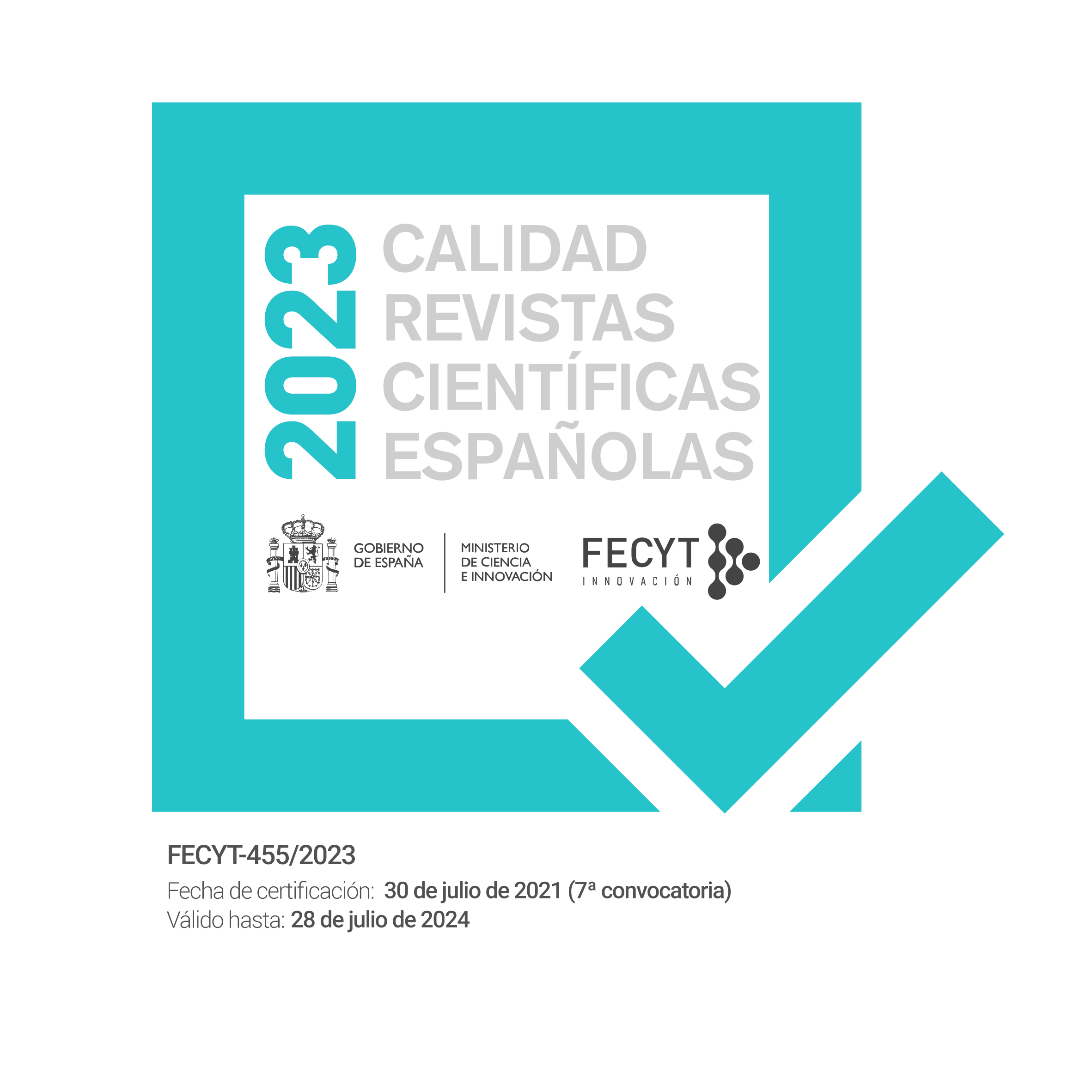Recrear el ritmo del octosílabo español: dos experimentos rusos en las décadas de 1930 y 1940
DOI:
https://doi.org/10.30827/cre.v20.30578Palabras clave:
verso octosílabo, traducción poética, traducción equirrítmica, Borís Yarjó, Konstantín Gúsev, Federico García LorcaResumen
El artículo presenta un análisis rítmico de algunas traducciones experimentales al ruso que imitan la estructura del verso octosílabo español. Se centra en los romances anónimos cidianos, interpretados por el eminente medievalista ruso Borís Yarjó y publicados en 1938, así como en los romances del Romancero gitano de Federico García Lorca, en la versión del olvidado poeta ruso Konstantín Gúsev y publicados entre 1941 y 1946. Aunque ambos traductores trabajaron de manera independiente, comparten un enfoque común, ya que buscan encontrar equivalentes formales para transmitir el ritmo del verso silábico español utilizando los recursos de la versificación rusa.
En este análisis, se examinan las características formales de las traducciones de Yarjó y Gúsev, como el cómputo silábico del verso y los patrones acentuales, en comparación con los textos originales y otras traducciones. La técnica de traducción empleada por Yarjó y Gúsev se basa en el principio de la copia rítmica: ambos traductores se esfuerzan por transmitir los rasgos acentuales y silábicos de los originales españoles de la forma más exacta posible, buscando crear en ruso una impresión acústica similar. Este enfoque se lleva a cabo incluso a nivel de cada verso: los traductores, especialmente Gúsev, se esmeran en garantizar que la recitación de los originales españoles corresponda a la de sus traducciones rusas.
Descargas
Citas
BAILEY, J. (1969). “Blok and Heine: An episode from the history of Russian dol’niki”. Slavic and East European Journal, 13(1), pp. 1–22. https://doi.org/10.2307/306620 DOI: https://doi.org/10.2307/306620
BAILEY, J. (1987). “An exploration in comparative metrics”. Style, 21(3), pp. 359–376. http://www.jstor.org/stable/42946211
COLOMBO, D. (1999). “Un esperimento sillabico nella poesia russa del Novecento”. Russica Romana, 6, pp. 165–185.
ERSHOVA, I. V. (2014). “Russkie perevody ispanskogo “starogo romansa”: razrushenie zhanra”. Voprosy literatury, 3, s.149–161.
FEDOROV, A. V. (1928). “Zvukovaya forma stikhotvornogo perevoda (Voprosy metriky i fonetiki)”. En: Poetika. [Vyp.] IV. Leningrad: Academia, s. 45–69.
FRANK, A. P. (2008). “Versification and stanza formation: Towards a transfer approach”. En Übersetzung — Translation — Traduction: An international encyclopedia of translation studies. Tbd. II. Berlín: De Gruyter, pp. 962–980. DOI: https://doi.org/10.1515/9783110137088.1.14.962
GARCÍA LORCA, F. (1968). Liriko (Trad. por K. Gusev; prólogo de A. Geleskul). Moscú: Komisiono pri Internaciaj Ligoj de Sovetaj Esperantistoj.
GASPAROV, M. L. (1974). Sovremennyi russkii stikh: Metrika i ritmika. Moskva: Nauka.
GASPAROV, M. L. (1981). “Ital’yanskii stikh: sillabika ili sillabo-tonika? (Opyt ispol’zovaniya veroyatnostnykh modelei v sravnitel’nom stikovedenii) ”. En: Problemy strukturnoi lingvistiki 1978. Moskva: Nauka, s. 199–218.
GASPAROV, M. L. (1990). “Bukvalizm slovesnyi protiv bukvalizma ritmicheskogo (Neizdannyi perevod iz «Pana Tadeusha»)”. En: Quinquagenario Alexandri Il’ushini oblata. Moskva: MGU, s. 53–62.
GASPAROV, M. L., TARLINSKAJA, M. (1987). “A Probability Model of Verse (English, Latin, French, Italian, Spanish, Portuguese)”. Style, 21(3), pp. 322–358. http://www.jstor.org/stable/42946210
GONCHARENKO, S. F. (1989). “Sillabichna li ispanskaya «sillabika»? (K voprosu ob adekvatnoi peredache metro-ritmicheskoi struktury pri poeticheskom perevode) ”. En: Tetradi perevodchika. Vyp. 23. Moskva: Institut mezhdunarodnykh otnoshenii, s. 122–131.
ILYUSHIN, A. A. (1986). “Slavyanskie i neslavyanskie istochniki russkoi sillabicheskoi poezii”. En: Literaturnye svyazi i literaturnyi protsess: iz opyta slavyanskikh literatur. Moskva: Nauka, s. 129–146.
KHARLAP, M. G. (1981). “Sillabika i vozmozhnosti ee vosproizvedeniya v russkom perevode”. En: Masterstvo perevoda. Sb. 12. Moskva: Sov. Pisatel’, s. 4–50.
LOTMAN, M.-K. (2012). “Equiprosodic translation method in Estonian poetry”. Sign Systems Studies, 40 (3/4), pp. 447–472. https://doi.org/10.12697/SSS.2012.3-4.10 DOI: https://doi.org/10.12697/SSS.2012.3-4.10
MESCHONNIC, H. (1982). Critique du rythme: anthropologie historique du langage. París: Verdier.
MESCHONNIC, H. (1999). Poétique du traduire. París: Verdier.
MICHAELIS, C. (1871). Romancero Del Cid: Nueva Edición Añadida Y Reformada Sobre Las Antiguas, Que Contiene Doscientos Y Cinco Romances Recopilados, Ordenados Y Publicados Por Carolina Michaelis. Leipzig: Brokhaus.
MUSAEVA, O. (2009). “K. M. Gusev — perevodchik F. Garsia Lorki”. En: Russkaya filologiya. 20. Sb. nauch. rabot molodykh filologov. Tartu: Izd. Tartuskogo universiteta, s. 123–129.
MUSAEVA, O. (2012). “Perevody «Romansa o lune, lune» i stanovlenie russkogo kanona perevodov F. Garsia Lorki”. Russkaya literatura, 1, s. 203–218.
PILSHCHIKOV, I. (2016). “The semiotics of phonetic translation”. Studia Metrica et Poetica, 3 (1), pp. 53–104. https://doi.org/10.12697/smp.2016.3.1.03 DOI: https://doi.org/10.12697/smp.2016.3.1.03
PILSHCHIKOV, I. (2022). “Formalismo cuantitativo “viejo” y “nuevo” (El Círculo Lingüístico de Moscú y el Laboratorio Literario de Stanford)”. Literatura: teoría, historia, crítica, 24(1), pp. 265–295. https://doi.org/10.15446/lthc.v24n1.98440 DOI: https://doi.org/10.15446/lthc.v24n1.98440
POLILOVA, V. (2018). “Spanish Romancero in Russian and the semantization of verse form”. Studia Metrica et Poetica, 5(2), pp. 77–108. https://doi.org/10.12697/smp.2018.5.2.04 DOI: https://doi.org/10.12697/smp.2018.5.2.04
POLILOVA, V. (2020). “Marina Tsvetáyeva, traductora de Federico García Lorca: historia y poética de las traducciones perdidas al francés”. Mundo Eslavo, 19, pp. 227–243. https://revistaseug.ugr.es/index.php/meslav/article/view/17715
POLILOVA, V. (2023). “¿Cómo evaluar la fidelidad de una traducción? Métodos cuantitativos en el estudio de las traducciones poéticas”. Literatura: teoría, historia, crítica, 25(2), pp. 21–59. https://doi.org/10.15446/lthc.v25n2.108772 DOI: https://doi.org/10.15446/lthc.v25n2.108772
POLILOVA, V. S. (2021). “Neizdannaya rabota B. I. Yarkho o poetike «Pesni o moem Side» i ego perevody srednevekovykh pamyatnikov”. En: Khudozhestvenno-filologicheskii perevod 1920–1930-kh godov. S.-Peterburg: Nestor-Istoriya, s. 101–145.
POLILOVA, V. S. (2023). “Sillabika, tonika, sillabotonika? Frantsuzskii desyatislozhnik v perevode B. I. Yarkho i var’iruemaya tzezura”. En: Poeziya filologii. Filologiya poezii. Vyp. 4: Sbornik materialov konferentsii, posvyashchyonnoi A. A. Ilyushinu. Tver’: Izdatel’ A. N. Kondratev, s. 56–67.
POLILOVA, V. S., PIL’SHCHIKOV, I. A., BELOUSOVA, A. S. (2022). “Sravnitel’noe stikovedenie v Rossii i za rubezhom”. Voprosy yazykoznaniya, 2, s. 125–150. https://doi.org/10.31857/0373-658X.2022.2.125-150. DOI: https://doi.org/10.31857/0373-658X.2022.2.125-150
PURISHEV, B. I. (1939). Khrestomatiya po zapadno-evropeiskoi literature: Dlya vysshikh ped. ucheb. zavedenii. Tom 1 (2-e izd. dop.). Moskva: Uchpedgiz.
SVETLAKOVA, O. A., KHOROST’YANOVA, E. V. (2010). “Ispanskie romansero v russkikh perevodakh”. En: Otechestvennoe stikovedenie: 100-letnie itogi i perspektivy razvitiya. S.-Peterburg: Filol. fak. Sankt-Peterb. gos. un-ta, s. 355–364.
TOMASHEVSKII, B. V. (1959). “Strofika Pushkina”. En: B. V. Tomashevskii. Stikh i yazyk. Moskva; Leningrad: Gos. izd-vo khudozh. lit., s. 202–324.
VOLEK, E. (2006). “Hry typologie a studium verše: český a španělský verš v zápasu o charakter a tvar sylabotónismu”. Česká literatura, 54(2/3), pp. 41–58. http://www.jstor.org/stable/42687150
YARKHO, B. I. (1934). Pesn’ o Rolande. Po Oksfordskomu tekstu. Per. so staro-frantsuzskogo, vstup. stat’ya i prim. B. I. Yarkho. Moskva; Leningrad: Gos. izd-vo khudozh. lit.












